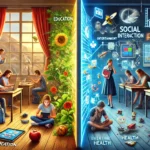As technology evolves rapidly, the lines between work and personal life are becoming increasingly blurred. This shift has a significant impact on both productivity and well-being. So, how can we effectively manage these modern workplace challenges without compromising our health and happiness?
In this article, we’ll explore the complex relationship between technology and work-life balance, covering its benefits, challenges, and practical solutions. Whether you’re an employer seeking a healthier work environment or an employee looking for better work-life integration, there are strategies to make technology work for you, not against you.
The Positive Side of Technology
Enhanced Communication and Collaboration
- Instant Connectivity: Tools like Slack, Microsoft Teams, and Zoom have revolutionized how teams interact. These platforms enable instant messaging and video calls, accelerating decision-making and allowing for more flexible working arrangements.
- Real-Time Project Collaboration: Software like Google Drive and Microsoft OneDrive lets multiple users work on the same document simultaneously, speeding up editing and feedback processes and reducing the clutter of email chains.
Flexibility and Remote Work Opportunities
- Work from Anywhere: Laptops, cloud computing, and mobile apps have freed work from being confined to a physical office. This flexibility can reduce stress and commuting time, allowing employees to create schedules that better fit their personal lives.
- Virtual Team Management: Tools like Trello, Asana, and Basecamp help manage remote teams by tracking tasks and deadlines, providing transparency, and fostering trust and autonomy.
Improved Employee Engagement
- Centralized Platforms: Social intranet software like SharePoint or Yammer creates a centralized space for sharing company news and fostering community.
- Gamification and Recognition: Tools that incorporate gamification and employee recognition can motivate and reward productivity, leading to a more engaged workforce.
The Negative Side of Technology
Blurred Boundaries Between Work and Personal Life
- Always-On Culture: Smartphones and laptops mean work notifications can follow you everywhere, making it difficult to disconnect and leading to stress and burnout.
- Lack of Downtime: Constant connectivity can erode natural boundaries, making it harder to find time for relaxation, hobbies, or exercise, which can negatively impact physical and mental health.
Increased Expectations and Workload
- Pressure to Overdeliver: Technological efficiency often sets unrealistic expectations for immediate responses and increased productivity, leading to longer work hours and higher stress levels.
- Perpetual Learning Curve: Constantly learning new tools and software can add extra pressure, often requiring time and effort outside of regular work hours.
Practical Solutions for Balancing Technology and Life
Setting Clear Boundaries
- Scheduled Downtime: Use tools like Google Calendar to visually separate work and personal time. Set “Do Not Disturb” hours to reduce notifications during off-hours.
- Turning Off Notifications: Disable work-related notifications after hours to maintain a healthy separation. Encourage colleagues to respect these boundaries.
Leveraging Technology Wisely
- Time Management Software: Apps like Toggl or RescueTime can help track work habits and improve productivity by identifying areas for improvement.
- Mindfulness and Wellness Apps: Incorporate wellness apps like Headspace for meditation or Fitbod for exercise routines to balance work-related technology use.
Promoting a Healthy Work Culture
- Encouraging Breaks and Vacations: Implement policies that encourage regular breaks and vacations to rejuvenate employees and boost productivity.
- Flexible Work Hours: Adopting flexible schedules helps employees manage personal and work commitments better, leading to happier and more motivated teams.
Success Stories: Companies Leading the Way
- Google: Known for its employee-friendly policies, Google offers flexible working hours, wellness programs, and even nap pods to ensure a healthy work-life balance.
- Buffer: This company offers remote work options, unlimited vacation days, and wellness stipends, demonstrating how technology can support an optimal work-life balance.
- Basecamp: With a no-overtime policy and emphasis on asynchronous communication, Basecamp promotes a balanced work environment and offers sabbaticals and comprehensive health benefits.
Conclusion
Technology’s impact on work-life balance is profound and multifaceted. While it offers benefits like increased flexibility and enhanced communication, it also poses challenges such as blurred boundaries and heightened expectations. However, by setting clear boundaries, using technology wisely, and promoting a healthy work culture, both employers and employees can navigate these challenges effectively.
Remember, technology itself isn’t inherently good or bad for work-life balance; it’s how we use it that makes the difference. By implementing practical solutions and fostering a supportive environment, we can enjoy a fulfilling career and a rewarding personal life.
















